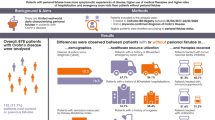Abstract
Background
Chronic anal fissure (CAF) is a common problem that causes significant morbidity. Little is known about the risk factors of CAF among patients with inflammatory bowel disease (IBD).
Aim
To study the clinical characteristics and prevalence of CAF among a cohort of IBD patients.
Methods
We performed a population-based study on IBD patients from the National Veterans Affairs administrative datasets from 1998 to 2011. IBD and AF were identified by ICD-9 diagnosis codes.
Results
We identified 60,376 patients with IBD between the ages of 18–90 years, 94 % males, 59 % diagnosed with ulcerative colitis (UC), and 88 % were Caucasians. The overall prevalence of CAF was 4 % for both males and females. African Americans (AA) were two times more likely to have CAF compared to Caucasians (8 vs. 4 %; OR 2.0, 95 % CI 1.6–20.2, p = 0.0001) or Hispanics (8 vs. 4.8 %; OR 2.1, 95 % CI 1.4–25.2, p = 0.0001). The prevalence of CAF significantly dropped with age from 7 % at age group 20–50 to 1.5 % at 60–90 (p = 0.0001). CD patients were two times more likely to have CAF than UC patients (6 vs. 3 %; OR 1.9, 95 % CI 1.5–18.2, p = 0.0001). The initial diagnosis of CAF occurred within 14 years after the initial diagnosis of IBD in 74.5 % patients.
Conclusions
CAF is more prevalent among IBD than what is reported in the general population and diagnosed after the diagnosis of IBD. CAF is more prevalent among patients with CD, younger patients, and AA. The current results lay the groundwork for further outcome studies relate to anal fissure such as utilization, hospitalization, and cost.


Similar content being viewed by others
References
Madalinski MH. Identifying the best therapy for chronic anal fissure. World J Gastrointest Pharmacol Ther. 2011;14:9–16.
Zaghiyan KN, Fleshner P. Anal fissure. Clin Colon Rectal Surg. 2011;14:22–30.
Lindsey I, Jones OM, Cunningham C, George BD, Mortensen NJ. Botulinum toxin as second-line therapy for chronic anal fissure failing 0.2 percent glyceryl trinitrate. Dis Colon Rectum. 2003;46:361–366.
Wollina U. Pharmacological sphincterotomy for chronic anal fissures by botulinum toxin a. J Cutan Aesthet Surg. 2008;1:58–63.
Medhi B, Rao RS, Prakash A, Prakash O, Kaman L, Pandhi P. Advances in the pharmacotherapy of chronic anal fissure: an update. Asian J Surg. 2008;3:154–163.
Mapel DM, Schum M, Worley AV. The epidemiology and treatment of anal fissures in a population-based cohort. BMC Gastroenterol. 2014;14:1–7.
Lund JN, Scholefield JH. Etiology and treatment of anal fissure. Br J Surg. 1996;83:1335–1344.
Williams DR, Coller JA, Corman ML, Nugent FW, Veidenheimer MC. Anal complications in Crohn’s disease. Dis Colon Rectum. 1981;24:22–24.
Sweeney JL, Ritchie JK, Nicholls RJ. Anal fissure in Crohn’s disease. Br J Surg. 1988;75:56–57.
Fleshner PR, Schoetz DJ Jr, Roberts PL, Murray JJ, Coller JA, Veidenheimer MC. Anal fissure in Crohn’s disease: a plea for aggressive management. Dis Colon Rectum. 1995;38:1137–1143.
Hou JK, Tan M, Stidham RW, et al. Accuracy of diagnostic codes for identifying patients with ulcerative colitis and Crohn’s disease in the Veterans Affairs Health Care System. Dig Dis Sci. 2014;59:2406–2410.
Isene R, Bernklev T, Høie O, et al. Extraintestinal manifestations in Crohn’s disease and ulcerative colitis: results from a prospective, population-based European inception cohort. Scand J Gastroenterol. 2015;50:300–305.
Vavricka SR, Brun L, Ballabeni P, et al. Frequency and risk factors for extraintestinal manifestations in the Swiss inflammatory bowel disease cohort. Am J Gastroenterol. 2011;106:110–119.
Marzano AV, Borghi A, Stadnicki A, Crosti C, Cugno M. Cutaneous manifestations in patients with inflammatory bowel diseases: pathophysiology, clinical features, and therapy. Inflamm Bowel Dis. 2014;20:213–227.
Siegel CA, MacDermott RP. Is chronic pain an extraintestinal manifestation of IBD? Inflamm Bowel Dis. 2009;15:769–771.
Sofia MA, Rubin DT, Hou N, Pekow J. Clinical presentation and disease course of inflammatory bowel disease differs by race in a large tertiary care hospital. Dig Dis Sci. 2014;59:2228–2235.
Lin KK, Sewell JL. The effects of race and socioeconomic status on immunomodulator and anti-tumor necrosis factor use among ambulatory patients with inflammatory bowel disease in the United States. Am J Gastroenterol. 2013;108:1824–1830.
Sewell JL, Inadomi JM, Yee HF Jr. Race and inflammatory bowel disease in an urban healthcare system. Dig Dis Sci. 2010;55:3479–3487.
Nguyen GC, LaVeist TA, Harris ML, Wang MH, Datta LW, Brant SR. Racial disparities in utilization of specialist care and medications in inflammatory bowel disease. Am J Gastroenterol. 2010;105:2202–2208.
Nguyen GC, Munsell M, Brant SR, LaVeist TA. Racial and geographic disparities in the use of parenteral nutrition among inflammatory bowel disease inpatients diagnosed with malnutrition in the United States. J Parenter Enteral Nutr. 2009;33:563–568.
Flasar MH, Johnson T, Roghmann MC, Cross RK. Disparities in the use of immunomodulators and biologics for the treatment of inflammatory bowel disease: a retrospective cohort study. Inflamm Bowel Dis. 2008;14:13–19.
Sainio P. Fistula-in-ano in a defined population. Incidence and epidemiological aspects. Ann Chir Gynnaecol. 1984;73:219–224.
Abramowitz L, Batallan A. Epidemiology of anal lesions (fissure and thrombosed external hemorrhoid) during pregnancy and post-partum]. Gynecol Obstet Fertil. 2003;31:546–549.
Acknowledgments
This project was supported by a grant from Aptalis Pharm.
Author information
Authors and Affiliations
Corresponding author
Ethics declarations
Conflict of interest
All the authors listed on the manuscript take full responsibility for the manuscript. There is no potential conflict of interest, real or perceived on submitting that manuscript. There are no prior publications or submissions of with any overlapping information.
Rights and permissions
About this article
Cite this article
Malaty, H.M., Sansgiry, S., Artinyan, A. et al. Time Trends, Clinical Characteristics, and Risk Factors of Chronic Anal Fissure Among a National Cohort of Patients with Inflammatory Bowel Disease. Dig Dis Sci 61, 861–864 (2016). https://doi.org/10.1007/s10620-015-3930-3
Received:
Accepted:
Published:
Issue Date:
DOI: https://doi.org/10.1007/s10620-015-3930-3



